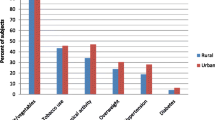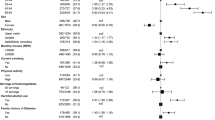Abstract
Objective
To identify the major risk factors for non-communicable diseases (NCDs) among the population of the capital city Male.
Methods
We undertook a cross-sectional survey among the 25–64-year-age group using a multi-stage sampling method with households as sampling unit. Information on behavioral, physiological, and biochemical risk factors was obtained through standardized methods as recommended by the STEPS survey guideline of the World Health Organization. Age-adjusted prevalence was calculated using the census figures for the year 2000.
Results
Among 2,028 individuals who participated in the survey, complete biochemical data were available for 1,506 subjects. The prevalence of NCD risk factors was high among both men and women in low education group: current smoking (39.9, 9.9%); overweight (BMI ≥ 23 kg/m2) (60.8, 65.5%); abdominal obesity (24.2, 54.1%); raised blood pressure (29.7, 32.9%); raised blood glucose (4.3, 4.7%); hypercholesterolemia (53.7, 54.9%).
Conclusion
The significant burden posed by the NCD risk factors along with the gender and socioeconomic differentials point to the need for public health action. The Ministry of Health has already initiated a comprehensive response to this threat. The experience and lessons from this survey will be useful for developing a comprehensive and sustainable surveillance system in the country.
Similar content being viewed by others
References
Anand K, Shah B, Yadav K, Singh R, Mathur P, Paul E, Kapoor SK (2007) Are the urban poor vulnerable to non-communicable diseases? A survey of risk factors for non-communicable diseases in urban slums of Faridabad. Natl Med J India 20(3):115–120
Department of Public Health (1997) Smoking survey, Malè
Kunst A (2009) Socioeconomic inequalities in health in Central and Eastern Europe: synthesis of results of eight new studies. Int J Public Health 54:197–200
Madarasova-Geckova A (2009) Can research contribute to the public capacity for activities that reduce socioeconomic inequalities in health? Int J Public Health 54:201–202
Merkin SS, Karlamangla A, Crimmins E, Charette SL, Hayward M, Kim JK, Koretz B, Seeman T (2009) Education differentials by race and ethnicity in the diagnosis and management of hypercholesterolemia: a national sample of US adults (NHANES 1999–2002). Int J Public Health 54(3):166–174
Ministry of Planning and National Development. (2000) Population and Housing Census of Maldives 2000, Republic of Maldives. Available from http://www.planning.gov.mv/publications/Pop_housing_census2000/index_p.htm
National Cholesterol Education Program (2001) Executive summary of the third report of the National Cholesterol Education Program Expert Panel on detection, evaluation, and treatment of high blood cholesterol in adults (Adult Treatment Panel-III). JAMA 285:2486–2497
National Heart, Lung, and Blood Institute Joint National Committee on Prevention, Detection, Evaluation, and Treatment of High Blood Pressure; National High Blood Pressure Education Program Coordinating Committee (2005) The Seventh Report of the Joint National Committee on Prevention, Detection, Evaluation, and Treatment of High Blood Pressure: the JNC 7 report. JAMA 289:2560–2572
Ng N, Stenlund H, Bonita R, Hakimi M, Wall S, Weinehall L (2006) Preventable risk factors for noncommunicable diseases in rural Indonesia: prevalence study using WHO STEPS approach. Bull World Health Organ 84(4):305–313
Reddy KS, Prabhakaran D, Jeemon P, Thankappan KR, Joshi P, Chaturvedi V et al (2007) Educational status and cardiovascular risk profile in Indians. Proc Natl Acad Sci USA 104:16263–16268
World Health Organization (1999) Definition, diagnosis and classification of diabetes mellitus and its complications: report of a WHO consultation. Part 1: diagnosis and classification of diabetes mellitus. WHO, Department of Noncommunicable Disease Surveillance, Geneva
World Health Organization (2000) Regional Office for the Western Pacific of the World Health Organization. International Association for the Study of obesity and international obesity task force. The Asia Pacific perspective: redefining obesity and its treatment. Health Communications Australia Pty Limited, Sydney
World Health Organization (2002) Noncommunicable diseases in South-east Asia Region—a profile. SEA/NCD/54 Regional Office for South-east Asia, New Delhi, pp 28–29
World Health Organization (2002) World Health Report 2002—reducing risks, promoting healthy life. Geneva
World Health Organization (2005) South East Asia Network for noncommunicable disease prevention and control. Report of the WHO Meeting, Bandos, Maldives, 7–10 November 2005. New Delhi World Health Organization, Regional Office for South-east Asia, 2006, SEA-NCD-71
World Health Organization Country Office for Maldives (2007a) WHO Country Cooperation Strategy 2007–2011. WHO, Republic of Maldives
World Health Organization. Regional Office for South-East Asia (2007b) 11 health questions about the 11 SEAR countries. New Delhi
World Health Organization (2008) The WHO STEPwise approach to Surveillance of chronic noncommunicable diseases risk factors. http://www.who.int/chp/steps/en. Accessed 2 Apr 2008
Acknowledgment
The authors acknowledge the technical support provided by World Health Organization particularly Dr. Jorge Mario Luna, WHO representative to Maldives and Dr. Ohn Kyaw and Dr. Rajesh Pandav of the WHO Country Office, Maldives and Dr. Jerzy Leowski, Regional Adviser, Noncommunicable Diseases, WHO Regional Office for South-East Asia. The field support provided by Diabetes and Cancer Society of Maldives for the clinical part of the survey and by Indira Gandhi Memorial Hospital (IGMH) for the laboratory work is appreciated. The assistance provided by VS Ajay, Research Fellow, Initiative for Cardiovascular Health in Developing Countries, New Delhi, India in statistical analysis and manuscript preparation is acknowledged.
Conflict of interest statement
None.
Author information
Authors and Affiliations
Corresponding author
Rights and permissions
About this article
Cite this article
Aboobakur, M., Latheef, A., Mohamed, A.J. et al. Surveillance for non-communicable disease risk factors in Maldives: results from the first STEPS survey in Male. Int J Public Health 55, 489–496 (2010). https://doi.org/10.1007/s00038-009-0114-y
Received:
Revised:
Accepted:
Published:
Issue Date:
DOI: https://doi.org/10.1007/s00038-009-0114-y




